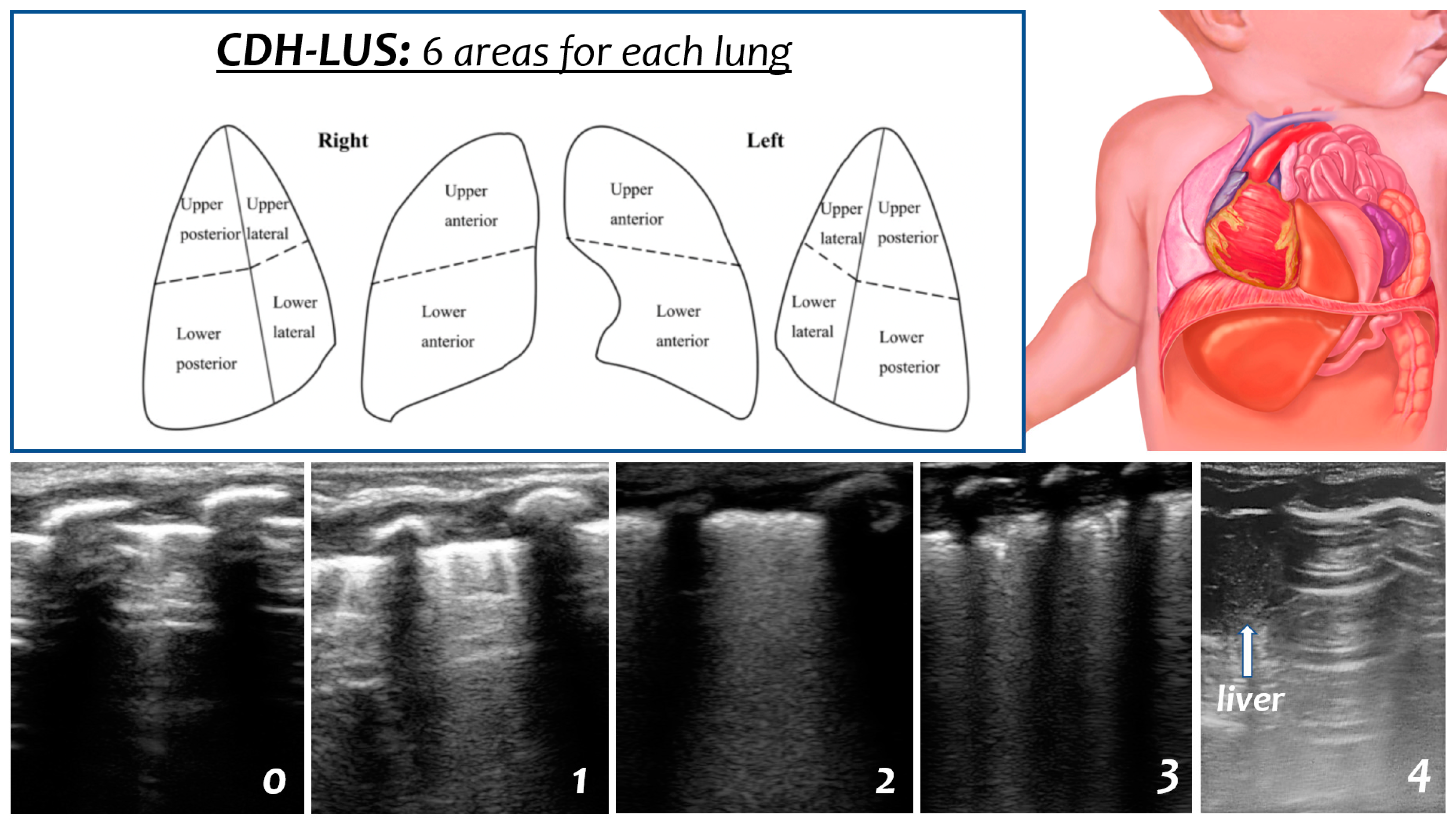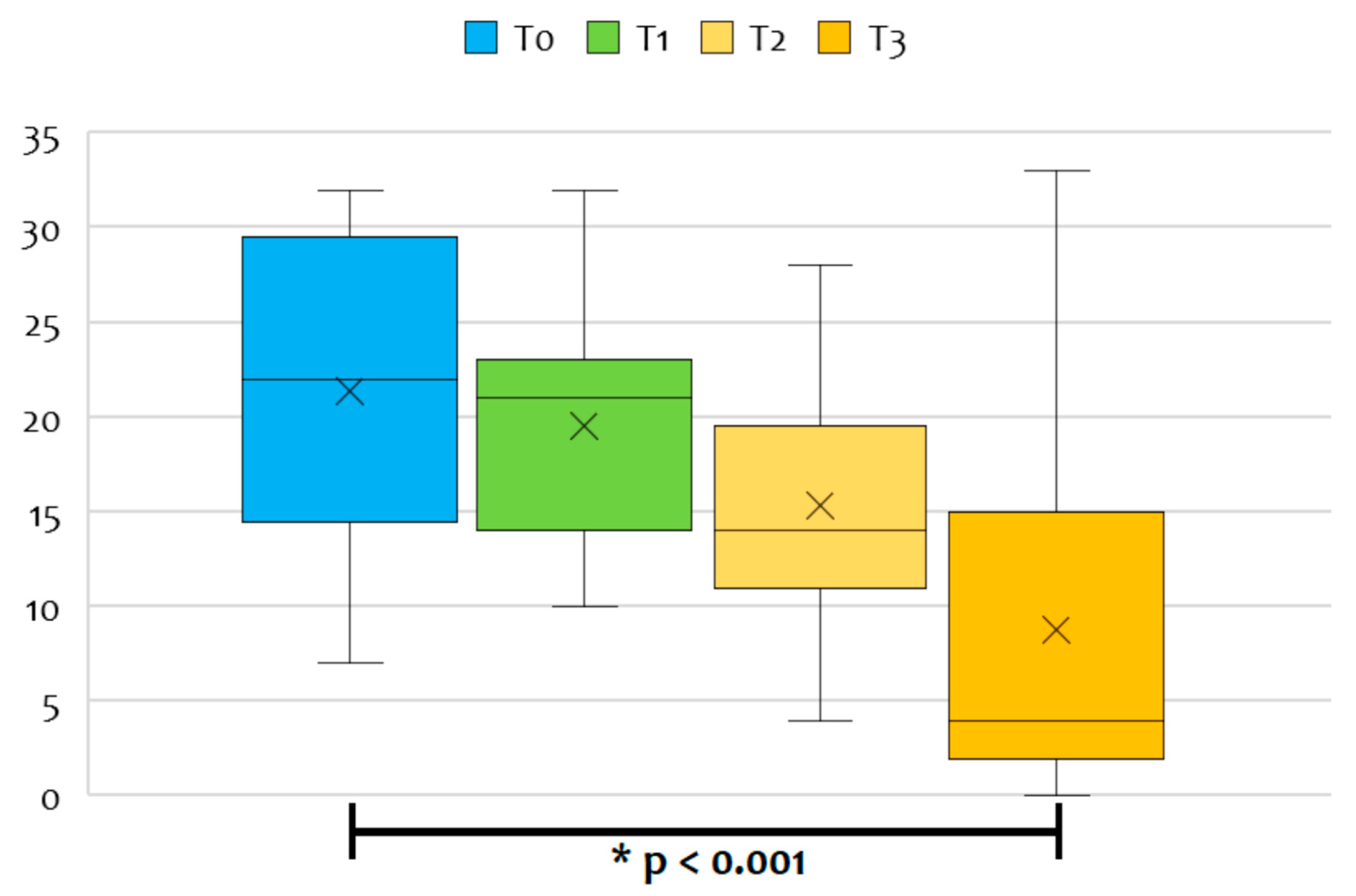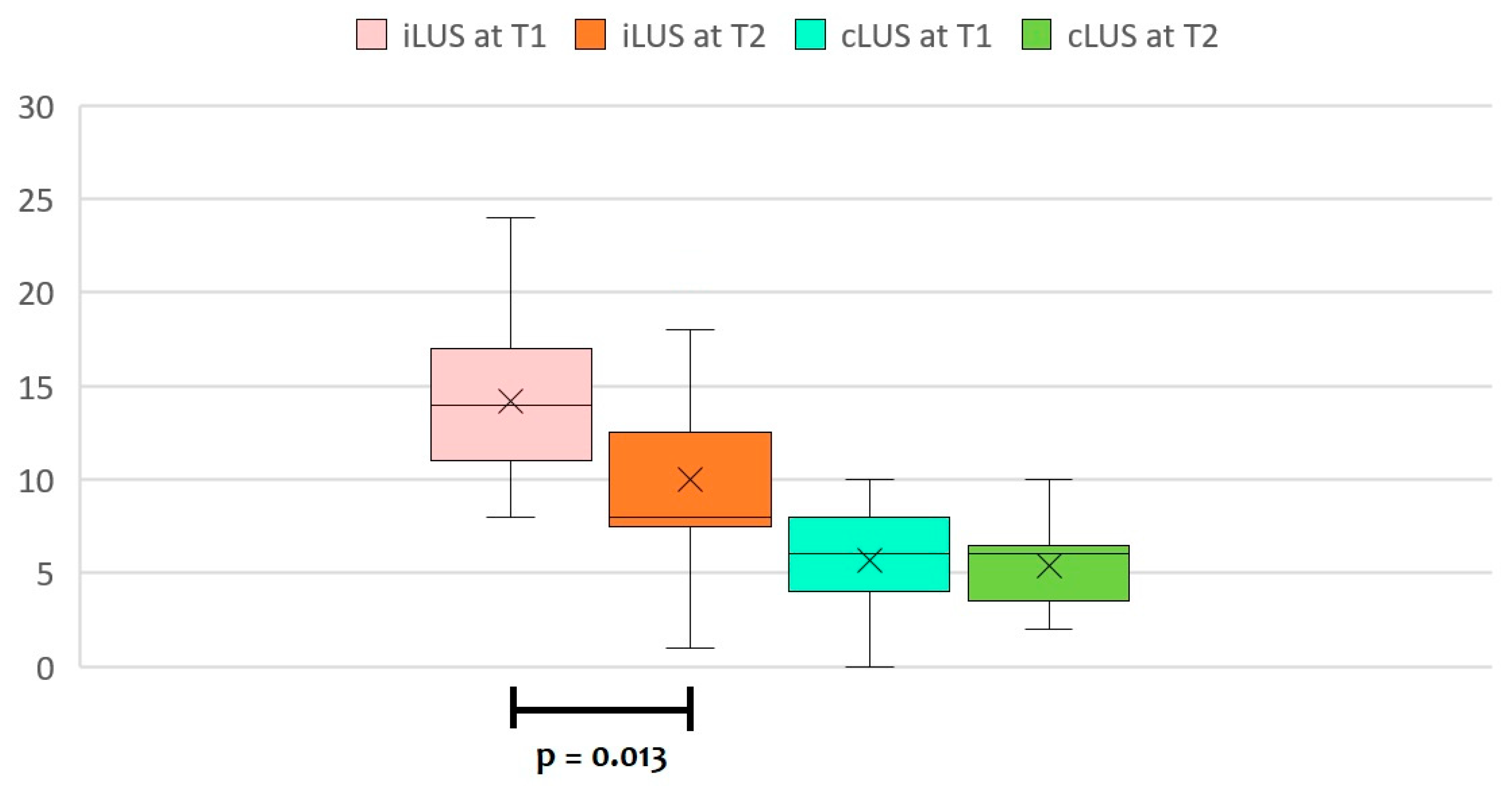Lung Ultrasound Score in Neonates with Congenital Diaphragmatic Hernia (CDH-LUS): A Cross-Sectional Study
Abstract
1. Introduction
2. Materials and Methods
2.1. Study Design
2.2. Lung Ultrasound Examinations
2.3. Objectives
2.4. Ethical Approval and Statistical Analysis
3. Results
4. Discussion
5. Conclusions
Author Contributions
Funding
Institutional Review Board Statement
Informed Consent Statement
Data Availability Statement
Conflicts of Interest
References
- Chatterjee, D.; Ing, R.J.; Gien, J. Update on congenital diaphragmatic hernia. Anesth. Analg. 2020, 131, 808–821. [Google Scholar] [CrossRef] [PubMed]
- Morini, F.; Lally, K.P.; Lally, P.A.; Crisafulli, R.M.; Capolupo, I.; Bagolan, P. Treatment strategies for congenital Diaphragmatic Hernia: Change sometimes comes bearing gifts. Front. Pediatr. 2017, 5, 195. [Google Scholar] [CrossRef] [PubMed]
- Morini, F.; Valfrè, L.; Bagolan, P. Long-term morbidity of congenital diaphragmatic hernia: A plea for standardization. Semin. Pediatr. Surg. 2017, 26, 301–310. [Google Scholar] [CrossRef] [PubMed]
- Mehollin-Ray, A.R. Prenatal lung volumes in congenital diaphragmatic hernia and their effect on postnatal outcomes. Pediatr. Radiol. 2022, 52, 637–642. [Google Scholar] [CrossRef] [PubMed]
- Danzer, E.; Rintoul, N.E.; van Meurs, K.P.; Deprest, J. Prenatal management of congenital diaphragmatic hernia. Semin. Fetal Neonatal Med. 2022, 27, 101406. [Google Scholar] [CrossRef] [PubMed]
- Corsini, I.; Parri, N.; Coviello, C.; Leonardi, V.; Dani, C. Lung ultrasound findings in congenital diaphragmatic hernia. Eur. J. Pediatr. 2019, 178, 491–495. [Google Scholar] [CrossRef] [PubMed]
- Raimondi, F.; Migliaro, F.; Corsini, I.; Meneghin, F.; Dolce, P.; Pierri, L.; Perri, A.; Aversa, S.; Nobile, S.; Lama, S.; et al. Lung ultrasound score progress in neonatal respiratory distress syndrome. Pediatrics 2021, 147, e2020030528. [Google Scholar] [CrossRef]
- Snoek, K.G.; Reiss, I.K.; Greenough, A.; Capolupo, I.; Urlesberger, B.; Wessel, L.; Storme, L.; Deprest, J.; Schaible, T.; van Heijst, A.; et al. Standardized postnatal management of infants with congenital diaphragmatic hernia in Europe: The CDH EURO Consortium Consensus—2015 Update. Neonatology 2016, 110, 66–74. [Google Scholar] [CrossRef]
- Gomond-Le Goff, C.; Vivalda, L.; Foligno, S.; Loi, B.; Yousef, N.; De Luca, D. Effect of Different Probes and Expertise on the Interpretation Reliability of Point-of-Care Lung Ultrasound. Chest 2020, 157, 924–931. [Google Scholar] [CrossRef]
- Brat, R.; Yousef, N.; Klifa, R.; Reynaud, S.; Shankar Aguilera, S.; De Luca, D. Lung ultrasonography score to evaluate oxygenation and surfactant need in neonates treated with continuous positive airway pressure. JAMA Pediatr. 2015, 169, e151797. [Google Scholar] [CrossRef]
- Cattarossi, L. Lung ultrasound: Its role in neonatology and pediatrics. Early Hum. Dev. 2013, 89, S17–S19. [Google Scholar] [CrossRef] [PubMed]
- Aichhorn, L.; Küng, E.; Habrina, L.; Werther, T.; Berger, A.; Urlesberger, B.; Schwaberger, B. The role of lung ultrasound in the management of the critically ill neonate-A narrative review and practical guide. Children 2021, 8, 628. [Google Scholar] [CrossRef] [PubMed]
- Raimondi, F.; Yousef, N.; Migliaro, F.; Capasso, L.; De Luca, D. Point-of-care lung ultrasound in neonatology: Classification into descriptive and functional applications. Pediatr. Res. 2021, 90, 524–531. [Google Scholar] [CrossRef] [PubMed]
- De Martino, L.; Yousef, N.; Ben-Ammar, R.; Raimondi, F.; Shankar-Aguilera, S.; De Luca, D. Lung ultrasound score predicts surfactant need in extremely preterm neonates. Pediatrics 2018, 142, e20180463. [Google Scholar] [CrossRef] [PubMed]
- Perri, A.; Tana, M.; Riccardi, R.; Iannotta, R.; Giordano, L.; Rubortone, S.A.; Priolo, F.; Di Molfetta, D.V.; Zecca, E.; Vento, G. Neonatal lung ultrasonography score after surfactant in preterm infants: A prospective observational study. Pediatr. Pulmonol. 2020, 55, 116–121. [Google Scholar] [CrossRef] [PubMed]
- Perri, A.; Sbordone, A.; Patti, M.L.; Nobile, S.; Tirone, C.; Giordano, L.; Tana, M.; D’Andrea, V.; Priolo, F.; Serrao, F.; et al. Early lung ultrasound score to predict noninvasive ventilation needing in neonates from 33 weeks of gestational age: A multicentric study. Pediatr. Pulmonol. 2022, 57, 2227–2236. [Google Scholar] [CrossRef]
- Raschetti, R.; Yousef, N.; Vigo, G.; Marseglia, G.; Centorrino, R.; Ben-Ammar, R.; Shankar-Aguilera, S.; De Luca, D. Echography-Guided Surfactant Therapy to Improve Timeliness of Surfactant Replacement: A Quality Improvement Project. J. Pediatr. 2019, 212, 137–143.e1. [Google Scholar] [CrossRef]
- Jancelewicz, T.; Brindle, M.E. Prediction tools in congenital diaphragmatic hernia. Semin. Perinatol. 2020, 44, 151165. [Google Scholar] [CrossRef]
- Patel, N.; Massolo, A.C.; Kraemer, U.S.; Kipfmueller, F. The heart in congenital diaphragmatic hernia: Knowns, unknowns, and future priorities. Front. Pediatr. 2022, 10, 890422. [Google Scholar] [CrossRef]
- Miller, L.E.; Stoller, J.Z.; Fraga, M.V. Point-of-care ultrasound in the neonatal ICU. Curr. Opin. Pediatr. 2020, 32, 216–227. [Google Scholar] [CrossRef]
- Singh, Y.; Tissot, C.; Fraga, M.V.; Yousef, N.; Cortes, R.G.; Lopez, J.; Sanchez-de-Toledo, J.; Brierley, J.; Colunga, J.M.; Raffaj, D.; et al. International evidence-based guidelines on Point of Care Ultrasound (POCUS) for critically ill neonates and children issued by the POCUS Working Group of the European Society of Paediatric and Neonatal Intensive Care (ESPNIC). Crit. Care 2020, 24, 65. [Google Scholar] [CrossRef] [PubMed]
- Landolfo, F.; De Rose, D.U.; Columbo, C.; Valfrè, L.; Massolo, A.C.; Braguglia, A.; Capolupo, I.; Bagolan, P.; Dotta, A.; Morini, F. Growth and morbidity in infants with Congenital Diaphragmatic Hernia according to initial lung volume: A pilot study. J. Pediatr. Surg. 2022, 57, 643–648. [Google Scholar] [CrossRef] [PubMed]



| Characteristics | CDH Patients (n = 13) |
|---|---|
| Males | 7 (53.8%) |
| Gestational age (weeks) | 37 (36–38) |
| Late preterm (34–36 weeks) | 4 (30.8%) |
| Birthweight (grams) | 2878 ± 682 |
| Birthweight Z-score (SDS) | 0.06 (−0.89/0.39) |
| Small for gestational age at birth | 1 (7.7%) |
| Observed/expected lung-area-to-head circumference ratio | 41 ± 12 |
| Fetal endoluminal tracheal occlusion (FETO) | 4 (30.8%) |
| Liver up | 6 (46.2%) |
| Defect size | |
| - A | 2 (15.3%) |
| - B | 5 (38.5%) |
| - C | 5 (38.5%) |
| - D | 1 (7.7%) |
| Patch repair | 4 (30.8%) |
| Age at surgery (hours of life) | 77 ± 43 |
| Length of hospital stay (days) | 33 ± 21 |
| Weight at discharge (grams) | 3306 ± 539 |
| Infants with a loss-of-weight Z-score of >1 SDS from birth to discharge | 10 (76.9%) |
| Factors | Mean Difference | Std. Error | 95% CI | p-Value | ||
|---|---|---|---|---|---|---|
| LUS_T0 | - | LUS_T1 | 1.846 | 1.480 | −2.820 to 6.512 | 1.000 |
| - | LUS_T2 | 6.077 | 2.376 | −1.415 to 13.569 | 0.151 | |
| - | LUS_T3 | 12.538 | 2.958 | 3.212 to 21.865 | 0.007 | |
| LUS_T1 | - | LUS_T0 | −1.846 | 1.480 | −6.512 to 2.820 | 1.000 |
| - | LUS_T2 | 4.231 | 1.791 | −1.415 to 9.877 | 0.215 | |
| - | LUS_T3 | 10.692 | 2.540 | 2.683 to 18.701 | 0.007 | |
| LUS_T2 | - | LUS_T0 | −6.077 | 2.376 | −13.569 to 1.415 | 0.151 |
| - | LUS_T1 | −4.231 | 1.791 | −9.877 to 1.415 | 0.215 | |
| - | LUS_T3 | 6.462 | 1.920 | 0.408 to 12.515 | 0.034 | |
| LUS_T3 | - | LUS_T0 | −12.538 | 2.958 | −21.865 to −3.212 | 0.007 |
| - | LUS_T1 | −10.692 | 2.540 | −18.701 to −2.683 | 0.007 | |
| - | LUS_T2 | −6.462 | 1.920 | −12.515 to −0.408 | 0.034 | |
| Factors | Mean Difference | Std. Error | 95% CI | p-Value | ||
|---|---|---|---|---|---|---|
| iLUS_T0 | - | iLUS_T1 | 0.538 | 0.931 | −2.397 to 3.474 | 1.000 |
| - | iLUS_T2 | 6.154 | 1.609 | 1.082 to 11.225 | 0.015 | |
| - | iLUS_T3 | 8.692 | 1.889 | 2.736 to 14.648 | 0.004 | |
| iLUS_T1 | - | iLUS_T0 | −0.538 | 0.931 | −3.474 to 2.397 | 1.000 |
| - | iLUS_T2 | 5.615 | 1.439 | 1.078 to 10.152 | 0.013 | |
| - | iLUS_T3 | 8.154 | 1.961 | 1.973 to 14.335 | 0.008 | |
| iLUS_T2 | - | iLUS_T0 | −6.154 | 1.609 | −11.225 to −1.082 | 0.015 |
| - | iLUS_T1 | −5.615 | 1.439 | −10.152 to −1.078 | 0.013 | |
| - | iLUS_T3 | 2.538 | 1.505 | −2.206 to 7.282 | 0.705 | |
| iLUS_T3 | - | iLUS_T0 | −8.692 | 1.889 | −14.648 to −2.736 | 0.004 |
| - | iLUS_T1 | −8.154 | 1.961 | −14.335 to −1.973 | 0.008 | |
| - | iLUS_T2 | −2.538 | 1.505 | −7.282 to 2.206 | 0.705 | |
| Factors | Mean Difference | Std. Error | 95% CI | p-Value | ||
|---|---|---|---|---|---|---|
| cLUS_T0 | - | cLUS_T1 | 1.308 | 0.873 | −1.443 to 4.059 | 0.959 |
| - | cLUS_T2 | −0.077 | 1.693 | −5.413 to 5.259 | 1.000 | |
| - | cLUS_T3 | 3.923 | 1.398 | −0.485 to 8.331 | 0.095 | |
| cLUS_T1 | - | cLUS_T0 | −1.308 | 0.873 | −4.059 to 1.443 | 0.959 |
| - | cLUS_T2 | −1.385 | 1.734 | −6.851 to 4.082 | 1.000 | |
| - | cLUS_T3 | 2.615 | 1.059 | −0.725 to 5.955 | 0.177 | |
| cLUS_T2 | - | cLUS_T0 | 0.077 | 1.693 | −5.259 to 5.413 | 1.000 |
| - | cLUS_T1 | 1.385 | 1.734 | −4.082 to 6.851 | 1.000 | |
| - | cLUS_T3 | 4.000 | 1.605 | −1.061 to 9.061 | 0.170 | |
| cLUS_T3 | - | cLUS_T0 | −3.923 | 1.398 | −8.331 to 0.485 | 0.095 |
| - | cLUS_T1 | −2.615 | 1.059 | −5.955 to 0.725 | 0.177 | |
| - | cLUS_T2 | −4.000 | 1.605 | −9.061 to 1.061 | 0.170 | |
Disclaimer/Publisher’s Note: The statements, opinions and data contained in all publications are solely those of the individual author(s) and contributor(s) and not of MDPI and/or the editor(s). MDPI and/or the editor(s) disclaim responsibility for any injury to people or property resulting from any ideas, methods, instructions or products referred to in the content. |
© 2023 by the authors. Licensee MDPI, Basel, Switzerland. This article is an open access article distributed under the terms and conditions of the Creative Commons Attribution (CC BY) license (https://creativecommons.org/licenses/by/4.0/).
Share and Cite
Maddaloni, C.; De Rose, D.U.; Ronci, S.; Bersani, I.; Martini, L.; Caoci, S.; Capolupo, I.; Conforti, A.; Bagolan, P.; Dotta, A.; et al. Lung Ultrasound Score in Neonates with Congenital Diaphragmatic Hernia (CDH-LUS): A Cross-Sectional Study. Diagnostics 2023, 13, 898. https://doi.org/10.3390/diagnostics13050898
Maddaloni C, De Rose DU, Ronci S, Bersani I, Martini L, Caoci S, Capolupo I, Conforti A, Bagolan P, Dotta A, et al. Lung Ultrasound Score in Neonates with Congenital Diaphragmatic Hernia (CDH-LUS): A Cross-Sectional Study. Diagnostics. 2023; 13(5):898. https://doi.org/10.3390/diagnostics13050898
Chicago/Turabian StyleMaddaloni, Chiara, Domenico Umberto De Rose, Sara Ronci, Iliana Bersani, Ludovica Martini, Stefano Caoci, Irma Capolupo, Andrea Conforti, Pietro Bagolan, Andrea Dotta, and et al. 2023. "Lung Ultrasound Score in Neonates with Congenital Diaphragmatic Hernia (CDH-LUS): A Cross-Sectional Study" Diagnostics 13, no. 5: 898. https://doi.org/10.3390/diagnostics13050898
APA StyleMaddaloni, C., De Rose, D. U., Ronci, S., Bersani, I., Martini, L., Caoci, S., Capolupo, I., Conforti, A., Bagolan, P., Dotta, A., & Calzolari, F. (2023). Lung Ultrasound Score in Neonates with Congenital Diaphragmatic Hernia (CDH-LUS): A Cross-Sectional Study. Diagnostics, 13(5), 898. https://doi.org/10.3390/diagnostics13050898







